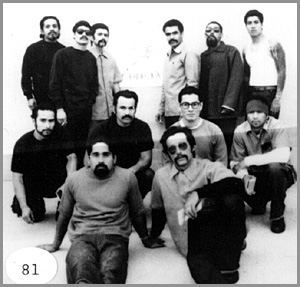|
Go Forth and Sin No More
Part 1 2 3 4
 | An early Nuestra Familia group photo - courtesy Jared Lewis |
Many states adopted fixed sentences, but over time, legislatures also began increasing the lengths of those sentences in a nationwide move to get tough on crime. Crime was rising dramatically, and in prison there was violence, often racial. Blacks and Latinos formed groups to protect themselves from the white prison establishment. Prisons were moving firmly away from rehabilitation. In 1977, California actually removed the term "rehabilitation" from the mission statement of the department of corrections. John Irwin says America looked to new ways to contain, not rehabilitate, violent prisoners
"That was part of the supermax thinking; places to hold people, incapacitate people for long periods of time," says Irwin. "But they were really based on the attempts to control this new obstreperous population of people who were into first racial violence and then gang violence."
"That was the reason for Pelican Bay," says Daniel Vasquez who worked in corrections for 30 years. He was warden of San Quentin Prison in the 1980s when courts approved the use of extreme isolation of inmates. That set in motion the rise of the supermax and the building of Pelican Bay State Prison in a remote corner of California's north coast.
"It was no man's land," says Vasquez. "Nobody wanted to be there, but that's where you went. And that was the end of the line for you. And we built this mammoth prison to house you under the most adverse conditions possible of isolation, of light deprivation and human deprivation because you were a tough dangerous gang member and, by gosh, we were going to treat you that way."
California's prison guards union produced a promotional video showing a life-and-death struggle between inmates and staff at Pelican Bay.
Behind the concrete and razor wire of California's prisons, you enter a world almost impossible to imagine. Brutal, violent, unpredictable, where gangs battle for control and inmates attack officers to make their bones.
The powerful union has lobbied for longer sentences and higher pay for prison staff.
Pelican Bay was built as two prisons in one. The outer ring is a maximum security facility. Within that is a structure that looks like a giant concrete and steel X. Inside the X, a labyrinth of halls and security checkpoints leads to the security housing unit, the SHU. The SHU contains more than 2,000 beds, and will also house men from other prisons who are involved in violence and gangs.
Pelican Bay's innovation was in fully automating cells. From a glass enclosed control booth, one officer can remotely control cells for more than 40 prisoners, leading them to showers and a small enclosed exercise pen. The aim was to limit contact, leaving inmates locked in their windowless cells, alone, for 22 or 23 hours a day.
Courts have consistently found that conditions in supermaxes do not constitute cruel and unusual punishment for most inmates, but Pelican Bay Prison did get in trouble with the courts soon after it opened. Guards were abusing and severely beating prisoners.
In 1995 a U.S. district judge found systematic abuses at Pelican Bay that were covered up by a pervasive code of silence among staff. The judge ordered inmates with mental disorders be removed from the SHU, and he imposed a federal monitor for the prison, something that continues to this day.
Lt. Steve Perez is Pelican Bay's spokesman.
"When you read what the court documented as the problems that were going on at Pelican Bay, it would be very foolish to say we didn't have issues here at Pelican Bay," says Perez. "We had significant issues. The reality is that you had a management team that came in and changed the culture of this institution working in harmony with the court and that's the way it should be."
Court monitors concur that Pelican Bay is a different institution today, but have these new prisons achieved their aim of containing crime? California's current prison population is more than 160,000. That's an eight-times increase from 1970. And crime is down in California, just as it is nationwide.
But recidivism in California is the highest in the country, and the supermax has not stopped prison gangs. The militant groups that emerged in the 1960s expanded into extortion and drug dealing, in prison and now on the streets.
Continue to part 3
| 
